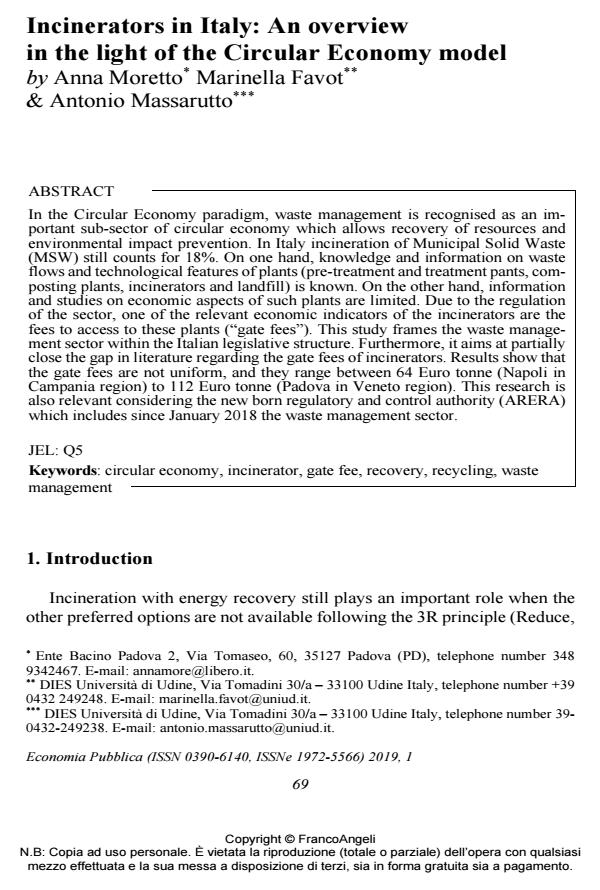Incinerators in Italy: An overview in the light of the Circular Economy model
Titolo Rivista ECONOMIA PUBBLICA
Autori/Curatori Anna Moretto, Marinella Favot, Antonio Massarutto
Anno di pubblicazione 2019 Fascicolo 2019/1 Lingua Inglese
Numero pagine 20 P. 69-88 Dimensione file 230 KB
DOI 10.3280/EP2019-001004
Il DOI è il codice a barre della proprietà intellettuale: per saperne di più
clicca qui
Qui sotto puoi vedere in anteprima la prima pagina di questo articolo.
Se questo articolo ti interessa, lo puoi acquistare (e scaricare in formato pdf) seguendo le facili indicazioni per acquistare il download credit. Acquista Download Credits per scaricare questo Articolo in formato PDF

FrancoAngeli è membro della Publishers International Linking Association, Inc (PILA)associazione indipendente e non profit per facilitare (attraverso i servizi tecnologici implementati da CrossRef.org) l’accesso degli studiosi ai contenuti digitali nelle pubblicazioni professionali e scientifiche
In the Circular Economy paradigm, waste management is recognised as an important sub-sector of circular economy which allows recovery of resources and environmental impact prevention. In Italy incineration of Municipal Solid Waste (MSW) still counts for 18%. On one hand, knowledge and information on waste flows and technological features of plants (pre-treatment and treatment pants, composting plants, incinerators and landfill) is known. On the other hand, information and studies on economic aspects of such plants are limited. Due to the regulation of the sector, one of the relevant economic indicators of the incinerators are the fees to access to these plants ("gate fees"). This study frames the waste management sector within the Italian legislative structure. Furthermore, it aims at partially close the gap in literature regarding the gate fees of incinerators. Results show that the gate fees are not uniform, and they range between 64 Euro tonne (Napoli in Campania region) to 112 Euro tonne (Padova in Veneto region). This research is also relevant considering the new born regulatory and control authority (ARERA) which includes since January 2018 the waste management sector.
Keywords:Circular economy, incinerator, gate fee, recovery, recycling, waste management
Jel codes:Q5
- Autorità Garante della Concorrenza e del Mercato (AGCM) (2016). IC49 - Indagine conoscitiva sul mercato dei rifiuti urbani: meno discariche più raccolta differenziata.
- Brinstengel et al. (2011). Treatment capacity and cross-boundary waste flows in Europe. ISWA Beacon Conference on Waste-to-Energy. Malmö. Sweden. November 3 2011.
- Decreto del direttore del dipartimento Ambiente n.10 del 31.01.2014 – Autorizzazione Integrata Ambientale (BUR Veneto n.38/2014). Delibera Giunta Regionale Veneto n. 955 del 28.07.2015 – Tariffa di conferimento dei rifiuti urbani dell’impianto di incenerimento rifiuti di Padova, anno 2015 (CTRA del 16.04.2015).
- EC European Commission (2012). Use of economic instruments and waste management performances. Final Report by Bio Intelligence Service. Contract ENV.G.4/FRA/2008/0112.
- EC European Commission (2013). Green Paper on a European Strategy on Plastic Waste in the Environment. Final report.
- EC European Commission (2015). The efficient functioning of waste markets in the European Union legislative and policy options. Final report.
- EEA-European Environment Agency (2014). Municipal Solid Waste Management Capacities in Europe. Desktop Study. ETC/SCP Working Paper No 8/2014.
- Hogg (2015). Costs for Municipal Waste Management in the EU Final Report to Directorate General Environment, European Commission. Eunomia research and consulting.
- Invitalia (2016). Assetti organizzativi del servizio di gestione rifiuti urbani Stato di attuazione dei processi di riordino.
- ISPRA (2016). Rapporto Rifiuti Urbani. Istituto Superiore per la protezione e la ricerca ambientale (Italian Institute for Environmental Protection and Research). Roma: ISPRA settore editoria.
- ISPRA (2017). Rapporto rifiuti urbani. Istituto Superiore per la protezione e la ricerca ambientale (Italian Institute for Environmental Protection and Research). Roma: ISPRA settore editoria.
- Law n. 205 of 27-Dec-2017
- Budget law -- http://www.gazzettaufficiale.it/eli/gu/2017/12/29/302/so/62/sg/pdf.
- Law n. 214 of 22-Dec-2011.
- Law n. 481 of 14-Nov-1995.
- Marques R.C., Simoes P. (2008). Does the sunshine regulatory approach work? Governance and regulation model of the urban waste services in Portugal. Resources, Conservation and Recycling, 52: 1040-49.
- Massarutto A. (2015). Economic aspects of thermal treatment of solid waste in a sustainable WM system. Waste Management, 37: 45-57.
- Merusi F., Atoniazzi S. (2017). Vent’anni di regolazione accentrata di servizi pubblici locali. Torino: Giappichelli.
- PEG BZ (2015). Piano economico gestionale sul periodo di vita minimo presunto (25 anni) dell’impianto di incenerimento rifiuti di Bolzano, anno 2015.
- Ref Ricerche srl. (2015). Rifiuti: a quando un’Autorità di regolazione indipendente?. Ambiente, 35.
- Ref Ricerche srl. (2017). L’Authority e le nuove competenze sul ciclo dei rifiuti: un floor normativo e competitivo per lo sviluppo industriale.
- Sora M.J., Ventosa P.I. (2013). Incineration Overcapacity and Waste Shipping in Europe: The End of the Proximity Principle?.
- Economic regulation of waste management utilities: Taking stock of the Italian reform Antonio Massarutto, in ECONOMICS AND POLICY OF ENERGY AND THE ENVIRONMENT 2/2021 pp.5
DOI: 10.3280/EFE2020-002001 - A new framework for policy evaluation: Targets, marine litter, Italy and the Marine Strategy Framework Directive Piero Morseletto, in Marine Policy 103956/2020 pp.103956
DOI: 10.1016/j.marpol.2020.103956
Anna Moretto, Marinella Favot, Antonio Massarutto, Incinerators in Italy: An overview in the light of the Circular Economy model in "ECONOMIA PUBBLICA " 1/2019, pp 69-88, DOI: 10.3280/EP2019-001004